
by Lori Vande Krol | May 12, 2025 | General Productivity, Habits, Motivation, Organization
I was recently quoted in an article on Redfin about how to get and stay motivated to clean your home. While home cleaning isn’t the focus of my business, the strategies I shared tie directly into the work I do every day with clients—helping them build sustainable systems for managing their time, space, and information.
Whether you’re tackling clutter on your kitchen counter or digital chaos in your inbox, the key to success is the same: consistent, manageable habits. It’s not as much about the task itself, but the habit of taking intentional action that creates lasting change. The best way to ensure intentional action is by scheduling those habits and routines into your weeks and days.
You can read the full article, and learn more expert tips for a tidier, calmer home, here: https://www.redfin.com/blog/how-to-stay-motivated-to-clean/
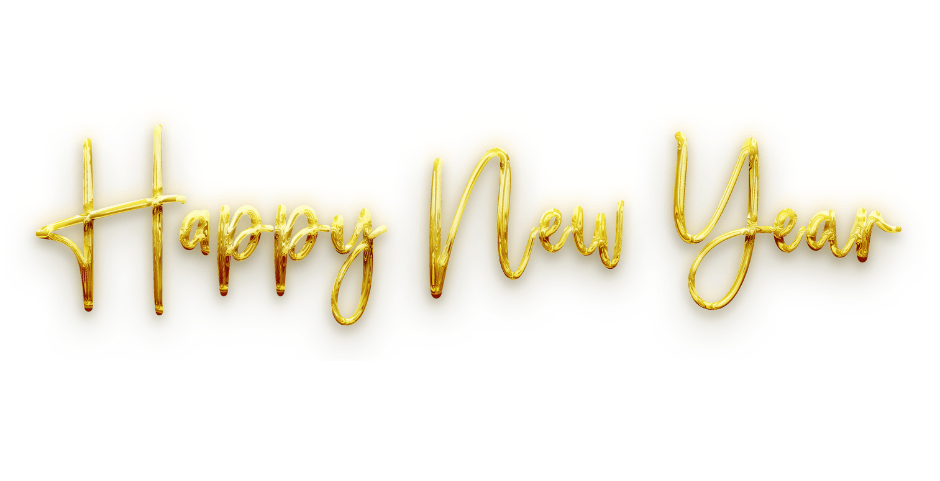
by Lori Vande Krol | Dec 27, 2024 | General Productivity, Goals and Priorities, Habits, Planning, Time Management
As 2024 comes to a close, it’s the perfect time to pause and reflect on the year. Looking back allows us to appreciate our achievements, learn from challenges, and set the stage for an even better year ahead. Here are a few questions to guide your reflection and help you prepare for a successful 2025:
- What did I accomplish this year? What am I most proud of? What victories, big or small, are worth celebrating?
- What actions contributed to my success this year? Which habits or strategies will I continue to build on?
- What were my biggest challenges? Were they avoidable? What can I do to prevent similar obstacles in the future?
- What will I do differently next year? What new actions or changes will I take to move forward?
- What is one specific area I can improve in 2025?
Now, grab your favorite notebook or journal, cozy up with a warm drink, and carve out some quiet time for self-reflection. This time is a gift — a chance to acknowledge your growth and set meaningful intentions for the year ahead.
Click here for a worksheet to support your Year in Review!

by Lori Vande Krol | Oct 10, 2024 | General Productivity, Habits, Mental Health, Time Management
In the midst of our busy lives, it’s often the smallest interactions that can ground us in the present and remind us of the beauty around us. I walked into a gas station recently, lost in my thoughts. Likely, I was mentally preparing for an upcoming meeting, running the day’s schedule through my mind, or brainstorming resolutions for challenges of my clients, my children, or myself. As I was checking out, the young cashier said, “I like your ring.”
“Thank you” I responded, half-aware. But her comment took me out of my thoughts and back to the present. I looked at her, actually noticed her, and realized she had a very cute hair style with pigtails and color that I could tell took some effort. I continued, “I like your hair.”
“Thank you!” she said. Then, “A nice compliment can go a long way.”
“Yes it can” I replied. In that moment, she not only gave me a reason to smile but brought me back to the present, to be mindful of that exact moment. I left a little lighter and happier. I have been working to be more mindful, more “in the moment,” because I understand how important it is for a happier, healthier life.
Simple Mindfulness Tips
If you often find yourself lost in thought, with lack of focus, or not able to enjoy the small moments, the practice of mindfulness may help. Mindfulness encourages us to reconnect with the present, enhancing our awareness of our surroundings and ourselves. By incorporating simple techniques into our daily routines, we can develop a greater sense of peace and appreciation for the little things in life. Here are some practical tips to get you started on your mindfulness journey:
1. Brain Dump: Clear your mind by doing a brain dump of everything that is distracting you. Choose a quiet space, set a timer for 10-15 minutes and write freely. Don’t worry about grammar, structure, or coherence—just let your thoughts flow. This can include worries, to-do lists, or random ideas.
After the timer goes off, take a moment to review what you wrote. Notice any recurring themes or feelings. This reflection can help you understand what’s on your mind and identify any areas where you might need to focus your attention. Then, make a plan to address them. Creating a habit of clearing your mind with a brain dump can be a powerful way to release mental clutter and create space for mindfulness in your day.
2. Practice: Being intentional and grounded consistently takes practice. One popular grounding method is the 5-4-3-2-1 Technique: Identify 5 things you can see, 4 things you can touch, 3 things you can hear, 2 things you can smell, and 1 thing you can taste. Other methods such as spending a few minutes outdoors, movement and stretching, or mindful breathing may work for you. Techniques such as this can bring you back to the present moment, allowing you to be more focused and mindful of your thoughts and decisions.
3. Reflect: Practice regular reflection and gratitude. One way to do this is to create a daily gratitude journal. Dedicate a few minutes each day, perhaps in the morning or before bed, to reflect on your day. List three things you are grateful for. They can be big or small—anything from a successful project at work to a beautiful sunset.
For each thing you list, take a moment to reflect on why you are grateful for it. Consider how it made you feel, why it matters to you, and the impact it had on your day. This practice not only enhances mindfulness by bringing your focus to the positive aspects of your life but also encourages a deeper understanding of what truly matters to you. Over time, it can help shift your perspective and cultivate a more positive mindset.
Thank you to my cashier that day, for bringing me out of my thoughts and back to the moment I was in. I needed a reminder to stop rushing, thinking, worrying, solving, planning…to notice and enjoy what was around me. Yes, I nice compliment can go a long way.

by Lori Vande Krol | Jan 11, 2024 | General Productivity, Goals and Priorities, Habits, Time Management
Have you set your 2024 goals? If so, you are ahead of many. In fact, you are in the top 14% of business professionals! Are they written down? Even better! Do you have specific strategies and milestones for achieving them? You are on your way to success!
But if you are like most, you are struggling to create clear annual goals with specific objectives and strategies. You may be procrastinating this process due to a lack of clarity, or you just don’t know where to start. Unfortunately, this often leads to another year where you are reacting to the latest “fire” or doing whatever is in front of you instead of prioritizing and making progress toward goals and priorities that will allow you to reach your vision and dreams. Why not take a different approach to annual goalsetting this year?
5 Annual Goalsetting Questions
Creating intentional, well-thought-out annual goals does not have to be difficult. You just need some focused time to answer the following questions (note these questions work for an individual, team, or business):
1. What do you want to achieve? Be thoughtful, specific, and clear.
2. Why does this goal matter to you? Why do you want to achieve it? How does it fit into your greater vision?
Honestly answering Question #2 may cause you to determine a goal is not important, does not support your greater mission or vision, or is not a priority right now. It is ok to put that goal aside to review in a future year, or remove it for good!
3. When do you want to achieve your goal?
Choose a target end date for your goal. Or, decide which quarter(s) of the coming year you will focus on the goal. Knowing your target date will help break the goal into intermediate milestones in Question #5 below.
4. Who will be involved? Do you have full control over the outcome of the goal? Do you need someone to provide support and accountability?
Use your answers from Questions 1-4 to write your goal in 1-2 sentences. Goals that are written are three times more likely to be achieved. Once you have a clearly written goal, it is time for Question #5.
5. How will you achieve your goal? What strategies or steps will you use? What are key milestones, including dates? List these strategies and target dates to ensure you are on track throughout the year.
5W1H Annual Goalsetting
These 5 questions form the basis of 5W1H Annual Goalsetting™: What, Why, When, Who, and How. (Wondering about the fifth “W”? The fifth “W” is to help you remember to “Write” it down!)
You may be familiar with SMART Goals: those that are specific, measurable, achievable, realistic, and time-bound. The 5W1H Goalsetting questions support the thought process needed to develop SMART Goals.
Use the button below to download a 5W1H Annual Goalsetting Template which includes space for answering each question and a table for recording your strategies and milestones. Choose one goal you want to achieve in 2024 to practice the process. Once you have that completed, choose another. Before you know it, you’ll be a pro!
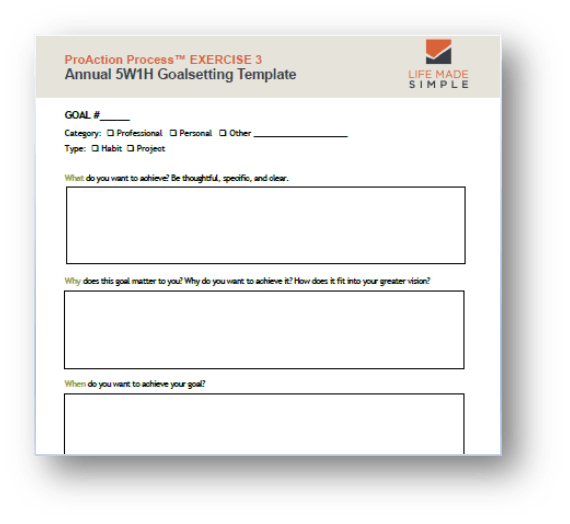
Annual 5W1H Goalsetting Template
FREE DOWNLOAD
Annual Goal Review and Tracking
When defining goals, it is important to distinguish between goals that are project-based and goals that are habits to create or change. How you define and track these two types of goals is very different. It is important to have a tool and process in place to regularly review and update your project-based goals as well as habit tracking tools for your habit-based goals. I will cover the review and tracking process, and potential tools, in a future blog. Stay tuned!
Help!
If you are still struggling with setting annual goals for yourself, your team, or your business, please reach out. I am here to help you clarify and reach your work and life goals.
Contact Lori at Life Made Simple or schedule your free 30-minute consultation.
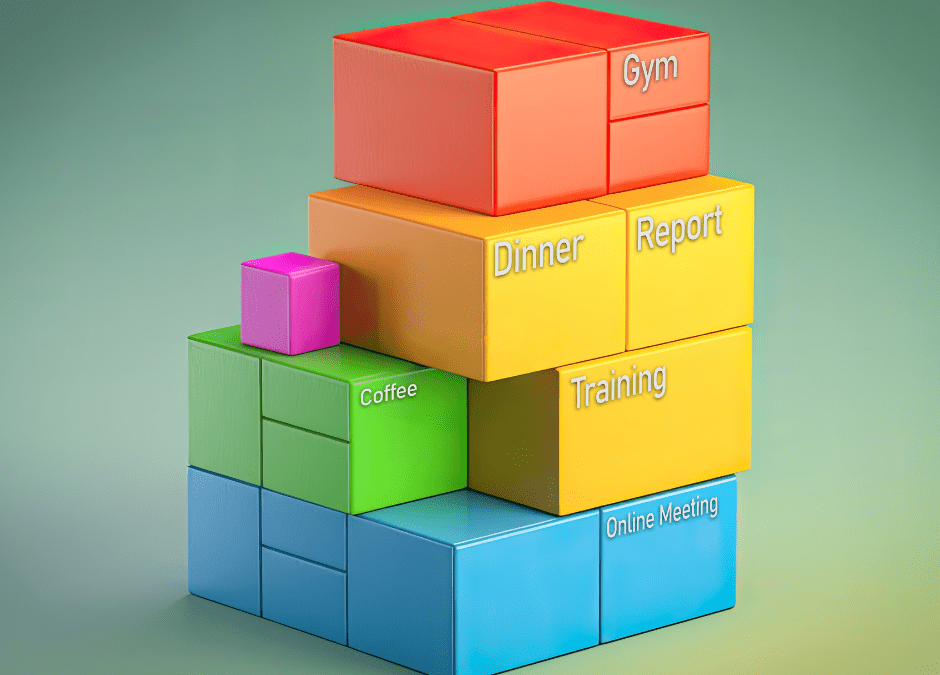
by Lori Vande Krol | Sep 7, 2023 | Goals and Priorities, Habits, Planning, Time Management, Tools
“I’ve tried time blocking in the past and it’s never worked for me.”
This was a recent statement from a client who I was helping with time management. Once we dug in more, we found it wasn’t that time blocking was an ineffective method, but that it wasn’t being applied in the most ideal way for him. This isn’t an uncommon complaint. In fact, even David Allen, productivity guru and author of Getting Things Done, used to argue against time blocking. He preferred a simple calendar with only the necessary appointments and deadlines. But eventually, he realized time blocking can work well for many people and even began practicing it himself.
Let’s dive a little deeper into what time blocking is, who can benefit (*hint* – everyone!), and how it might work best for you. I also share tips, tools, and resources to support your time-blocking habits.
Wikipedia defines Time Blocking as:
“A productivity technique for personal time management where a period of time—typically a day or week—is divided into smaller segments or blocks for specific tasks or to-dos. It integrates the function of a calendar with that of a to-do list. It is a kind of scheduling.”
While I agree with this definition of time blocking, there is much more to it than this.
Who should use a time-blocking technique?
Time blocking is best used for people who:
- Have a busy schedule and need to be very intentional about how they use their time,
- Have a fairly open schedule that can be wasted away if time is not blocked to work on specific tasks and projects (aka Parkinson’s Law),
- Reach the end of a day or week feeling stressed and unaccomplished, wondering where the time went,
- Juggle multiple areas of work and life,
- Struggle to find time for focus and big-picture thinking,
- Deal with constant interruptions, or
- Spend too much time “reacting” to the day’s urgencies.
If we are honest, isn’t this all of us at one point or another? I believe that some form of time blocking can work for almost everyone. The key is finding the method, or combination of methods, that works best for you.
Types of Time Blockers
While there are many different ways to apply time blocking to your calendar, we can simplify it by looking at three key methodologies.
1. The Serious Blocker divides their day into specific blocks of time, each dedicated to accomplishing a specific task, or group of tasks. They start each day, or week, with a concrete schedule that lays out what they will work on and when. A serious blocker will work to bunch related tasks (i.e. “task batching”) such as email processing, social media creation, or phone calls, into one block.
In addition, the serious blocker lumps meetings together. That way, they can spend larger chunks of time on focused projects and tasks versus shorter amounts of time spread between meetings throughout the day. This type of time blocking requires more work upfront, and potential cooperation from others, to reschedule meetings that will better fit your ideal schedule.
2. The Flexible Blocker applies time blocking in a broader way, with more general blocks that are flexible depending on what comes up throughout the day. This works well when your days are less predictable and require a more “reactive” approach (e.g. a customer service specialist). Some argue that these types of schedules aren’t compatible with time blocking, but when your workday is often run by outside forces, it’s easy to lose sight of your own goals. Even a simple version of time blocking can help you gain a greater sense of control over unpredictable schedules. You can still block off time for your “reactive work,” and then be more intentional about time during the day that allows for some planning and control (regardless of how little).
3. The Time Themer chooses themes for work they will do during certain time blocks. This is the most open-ended version of time blocking. “Day theming” is the most popular example where you choose a theme for each day of the week. For example: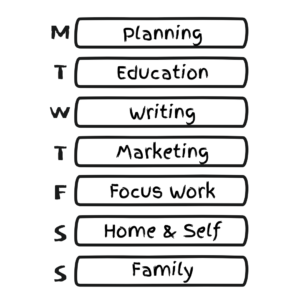
Any open time is spent on that day’s area of focus. Day theming minimizes the choices you need to make about what to work on throughout the day. You look to your theme and choose tasks based on that theme.
You can also use time theming to break up your day by assigning themes to blocks of time throughout the day. An example of this would be: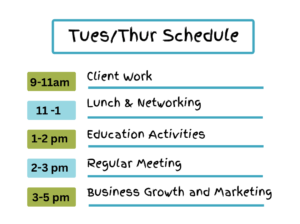 The schedule may be the same every day or may differ throughout the week. In the example above, Tuesday and Thursday have the same “themed schedule” while the other days look different. In the resources section below I share a template called My Productive Week that can be of great assistance in defining your daily “theme blocks.”
The schedule may be the same every day or may differ throughout the week. In the example above, Tuesday and Thursday have the same “themed schedule” while the other days look different. In the resources section below I share a template called My Productive Week that can be of great assistance in defining your daily “theme blocks.”
Most people do not fit perfectly into one time theming option but instead use a combination. For example, having a schedule of daily themes can make it easier to determine what tasks to put into working time blocks when using the “serious” or “flexible” blocking methods.
The Benefits of Time Blocking
While it takes some work, and potentially a change in mindset, the following benefits of time blocking show the value of this time management methodology.
- Your need to make decisions at every point in time throughout the day is minimized because your schedule is pre-defined. This saves time and energy throughout your week.
- If you get easily distracted or off-track, a time-blocked calendar will help to pull you back into focus. In addition, time blocking helps to fight multi-tasking allowing you to focus all of your energy on one thing at a time.
- You will get more realistic about how long things take. We often underestimate the time tasks and activities take, and this is a concrete way to see that. This will get better over time.
- When you see your priorities laid out in your finite calendar, you can more easily say “no” to those things that don’t fit.
- You are more likely to accomplish your goals if you schedule specific, intentional time to work on them.
- It will be easier to relax during your leisure time as you know you have a plan to get everything done.
“A 40 hour time-blocked work week, I estimate, produces the same amount of output as a 60+ hour work week pursued without structure.”
– Cal Newport, Author of Deep Work –
Tips for Effective Time Blocking
Below are key things to consider when working to design and maintain your own time-blocking routine.
- Build your time-blocking methodology into regular weekly planning. Look at your upcoming schedule, deadlines, and tasks and fit it all together to create a week that takes into account your goals, priorities, and commitments.
- Review your schedule daily and reset your week as necessary.
- Your routines and habits should be incorporated into your time blocks.
- Leave a time block for an overflow of tasks that take longer than expected or for unexpected appointments or to-dos that come up during the week.
- Once your week is planned, make intentional choices when straying from that plan.
- Leave space between, or within, blocks for transition, travel, time, and necessary breaks.
- Bunch your urgent but less important work together and dedicate a pre-determined amount of time to it. This allows for longer, uninterrupted time for focused work.
- Consider your daily rhythms in your schedule. When are you most energetic, productive, or focused?
- Evaluate your time-blocking schedule regularly and make needed changes.
- When scheduling time blocks for focused work, find a quiet location free of interruptions and/or block notifications on your computer and phone.
- Consider whether you want to block time on weekends (or other non-working days). You may want to leave these times open to allow freedom and flexibility with leisure time.
Most importantly, remember your time-blocked schedule is a guide to assist you with creating your most productive week. If you try to stick to it perfectly, especially at first, you will get overwhelmed when things come up that cause needed changes to your schedule. Review, reset with intentional decisions, and move forward. You might look at time blocking as a game or a puzzle. How can I fit it all in the most optimal way? But as with any game, you will make mistakes, learn along the way, and get better with practice.
Time Blocking Resources
The following resources can help you create your own time-blocked schedule.
- My Productive Week Template
I have created this tool as a template to build your “puzzle” for your time-blocked weekly calendar. It is to be used as a guide – along with your weekly schedule, goals, and tasks – for your weekly planning. The template can be completed digitally or printed.
- The ProAction Planner:
If you prefer to do your weekly planning with a paper planner, which allows for better mental processing and decision-making, the ProAction Planner is a tool to support all of the important areas of planning and time management. A paper planner provides an easy visual that stays in front of you throughout your day. If using a paper planner, I recommend using a writing instrument that allows for change throughout the week. My tool of choice is the Frixion Clicker Erasable Gel Pen, in multiple colors.
- Online Calendar (Outlook, Google, Other)
Whether or not you use a paper planner for weekly planning, the majority of us use an online calendar to keep track of our meetings and appointments. If you choose to use an online calendar for time-blocking, consider color-coding the blocks of time you wish to be flexible. I like to color my movable time blocks with yellow and mark them as “free.” Also consider those time blocks that you want to protect, mark them as busy, and consider them a meeting with yourself.
- Pomodoro Technique and Tools
The Pomodoro Technique is a method in which you focus for timed periods with short breaks between blocks. Learn more about this technique on their website and search for apps like this one to support the technique.
If you are interested in some assistance in determining and implementing the right time-blocking solution for you, please reach out. I’d love to help.

by Lori Vande Krol | Feb 6, 2023 | General Productivity, Goals and Priorities, Habits, Planning, Time Management
Julie reached out because she had reached a point of extreme frustration and overwhelm. She felt she was constantly trying to catch up, never finding time for her “important but nonurgent” tasks and projects, always worried about what she might be missing, and therefore not truly enjoying her work or personal time. Julie was always reacting to the latest emergency, others’ priorities become her priorities, and she would reach the end of the day, the week, and the year feeling drained, overwhelmed, and unaccomplished. Does this sound familiar?
After talking with Julie, we established that one change she needed was to incorporate a better system and tools for planning her time – her years, months, weeks, and days. An effective plan, and strategy to follow and maintain it, allows Julie to better understand her goals and priorities, and to make better decisions and choices throughout her days. Here I share ten proven strategies for incorporating effective planning into your own days and weeks.
1. Clarify your goals and priorities.
What is important to you in work and life? What do you hope to achieve in the long-term and short-term? If you aren’t clear on what your goals and priorities are, you can never know if you are working on the right thing at any point in time. This clarity will be the basis for your plan and the choices you make throughout the day.
2. Break down your goals into strategies and milestones.
As an elephant lover, I hate to use the saying “How do you eat an elephant? One bite at a time.” But it is a good metaphor for attacking your long-term and short-term goals. Once you know what you want to accomplish, you can break your goals into smaller pieces by defining the strategies you will use and when you will achieve various milestones.
3. Create your habits and routines.
Without good habits and routines, it is easy to let your days and weeks slip away without focusing on what is most important. Spend some time figuring out how you will incorporate the needed activities and time to reach your goals. List the habits you want to follow annually, monthly, weekly, and daily. Define daily routines such as tasks or actions you will take each morning, start of day, end of day, and evening.
4. Establish your boundaries.
It is likely that you will need to establish new boundaries in order to be successful in reaching your goals and sticking with your plan. Some examples might include:
- I will return emails and phone calls within 24 hours.
- I will take 1 day to review any new priorities, tasks, or projects before providing an answer.
- I will say “no” to anything that does not support my annual goals.
- I will not take on new volunteer positions this year.
- I will not respond to email or text after 6pm or on weekends.
- I will be in bed by 11pm and up by 7am each day.
Choose boundaries that work for your needs and personality and that will help you to reach your goals.
5. Get the right people on board.
Who will be impacted by your goals, strategies, habits, and routines? Do you have someone to help hold you accountable? Who can help support your plan? Be sure these people are aware of your plan, your boundaries, and how they can help you be successful.
6. Clear your space and your mind.
Take time regularly to clear your physical, digital, and mental space. If necessary, set aside a day or more to create an environment where you can focus and be intentional.
7. Determine the right tools.
What tools can you use to support your planning, focus, and daily intention and action? My favorite tools for daily and weekly planning are Microsoft Outlook/Tasks and the ProAction Planner. Do your research and find tools that will allow you to plan, reflect, track, and maintain. When working with others, it is also important to implement tools that will help you plan, collaborate, and track projects and tasks with them. Examples include Microsoft Planner and Teams, Asana, Trello, and Google Workspace. These are just a few of the many options available. Be sure to determine your needs and find what will best fit those needs.
8. Plan your weeks and days.
Set aside time regularly to plan your weeks and days based on your annual goals, habits, routines, and other priorities. Block time for the important, but nonurgent, projects and tasks. While it is rare that your week will go exactly as planned, having this basis as you begin your week will provide control and perspective, and allow you to make better-informed decisions when new urgencies arise.
9. Track.
Incorporate a system to track progress on your projects, goals, and habits. Review this regularly in order to evaluate and reset as needed throughout the year. You might also consider a look at how you spend your time and how closely you stick to your plan. Each day, evaluate challenges and areas for improvement. Small changes can yield big results.
10. Reflect and improve.
In addition to tracking your progress, schedule regular time to reflect on your results in order to make appropriate adjustments and allow for continuous improvement. This might include a quick daily and/or weekly reflection, a more thoughtful monthly reflection, and a deeper annual review and reflection. What went well? What challenges did you face? What will you stop, start, or continue doing? This is also a great time to practice gratitude. Be kind to yourself and others.
After clarifying her goals and priorities and putting the systems above in place to fit her needs, work, and lifestyle, Julie is feeling much more in control of her time. She is living intentionally and working proactively which has reduced stress and overwhelm. But the biggest and best change is that Julie is enjoying her work again and is able to focus on those people and things that matter most in life.
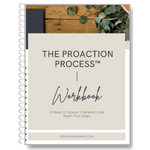
Need some tools to assist with the areas above? Check out our new ProAction Process™ Workbook packed full of tips, templates, worksheets, and exercises to support these areas of planning and more.
If you’d like a partner in helping you address your overwhelm and reach your goals, I’d love to talk. Reach out or schedule your free 30-minute consultation.








 The schedule may be the same every day or may differ throughout the week. In the example above, Tuesday and Thursday have the same “themed schedule” while the other days look different. In the resources section below I share a template called My Productive Week that can be of great assistance in defining your daily “theme blocks.”
The schedule may be the same every day or may differ throughout the week. In the example above, Tuesday and Thursday have the same “themed schedule” while the other days look different. In the resources section below I share a template called My Productive Week that can be of great assistance in defining your daily “theme blocks.”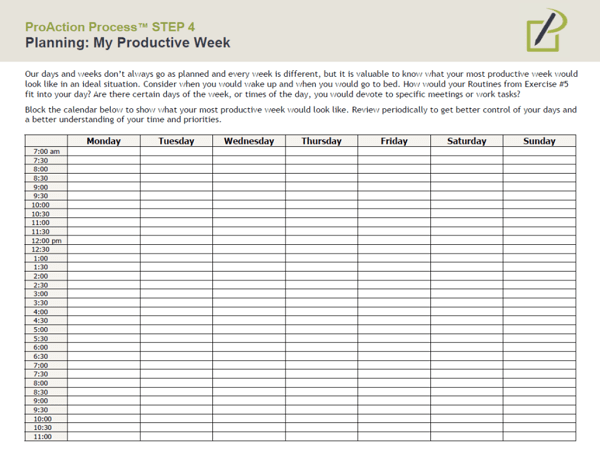

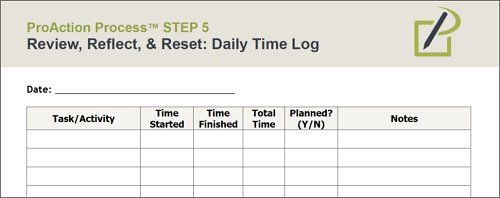

Recent Comments